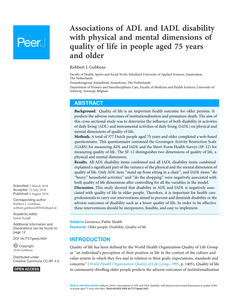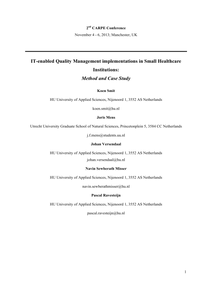from the article: Abstract Based on a review of recent literature, this paper addresses the question of how urban planners can steer urban environmental quality, given the fact that it is multidimensional in character, is assessed largely in subjective terms and varies across time. The paper explores three questions that are at the core of planning and designing cities: ‘quality of what?’, ‘quality for whom?’ and ‘quality at what time?’ and illustrates the dilemmas that urban planners face in answering these questions. The three questions provide a novel framework that offers urban planners perspectives for action in finding their way out of the dilemmas identified. Rather than further detailing the exact nature of urban quality, these perspectives call for an approach to urban planning that is integrated, participative and adaptive. ; ; sustainable urban development; trade-offs; quality dimensions
DOCUMENT

Background. Quality of life is an important health outcome for older persons. It predicts the adverse outcomes of institutionalization and premature death. The aim of this cross-sectional study was to determine the influence of both disability in activities of daily living (ADL) and instrumental activities of daily living (IADL) on physical and mental dimensions of quality of life. Methods. A total of 377 Dutch people aged 75 years and older completed a web-based questionnaire. This questionnaire contained the Groningen Activity Restriction Scale (GARS) for measuring ADL and IADL and the Short-Form Health Survey (SF-12) for measuring quality of life. The SF-12 distinguishes two dimensions of quality of life, a physical and mental dimension.
DOCUMENT

Digitalization enables public organizations to personalize their services, tuning them to the specific situation, abilities, and preferences of the citizens. At the same time, digital services can be experienced as being less personal than face-to-face contact by citizens. The large existing volume of academic literature on personalization mainly represents the service provider perspective. In contrast, in this paper we investigate what makes citizens experience a service as personal. The result are eight dimensions that capture the full range of individual experiences and expectations that citizens expressed in focus groups. These dimensions can serve as a framework for public sector organizations to explore the expectations of citizens of their own services and identify the areas in which they can improve the personal experiences they offer.
MULTIFILE

Experience quality has been studied for many decades in various contexts. While understanding of experience quality has advanced, its context-specific and multi-dimensional nature has challenged its conceptualisation. With the rise of experiential accommodation in tourism and hospitality, luxury lodges have been increasingly recognised in the industry and by customers as the emblem of luxury experiences, albeit receiving limited scholarly attention. Through a qualitative multiple-case study methodology, utilising high-engagement research techniques, this study explores the dimensions and determinants of luxury lodge experience quality. The study presents an experience quality model grounded in empirical data, bridging various experience quality theoretical perspectives to explain the luxury lodge experience, and demonstrating generalisation capabilities for other service contexts. The study contributes to the ongoing discourse on experience quality, particularly in the context of small luxury accommodation. The study also offers important practical implications for luxury accommodation operators on designing, staging and managing quality experiences.
DOCUMENT
There are lots of definitions of quality, and also of quality in education. Garvin (1984)discerns five approaches: the transcendental approach, the product-oriented approach, the customeroriented approach, the manufacturing-oriented approach and the value-for-money approach. Harvey and Green (1993) give five interrelated concepts of quality as: exceptional, perfection (or consistency), fitness for purpose, value for money and transformative. A new definition of quality is needed to explain recent quality issues in higher education. This article describes a quality concept with four constituents: object, standard, subject and values. The article elaborates on the values. Four value systems derived from Beck and Cowan (1996) are transformed into four value systems on quality and quality management: control, continuous improvement, commitment and breakthrough. These value systems make it possible to explain some recent developments in quality management in higher education.
DOCUMENT

A positive experience of the perinatal period is significant for women in midwifery care. The literature on women’s experiences of the care in this period is extensive. However, a clear overview of the dimensions important for women’s experiences is lacking. Consequently, care providers and researchers may ignore aspects significant to women’s experience. In this short communication, we present a framework identifying the dimensions relevant for women’s experiences of the perinatal period.
DOCUMENT

Staffing practices in long-term care lack a clear evidence base and often seem to be guided by opinions instead of evidence. While stakeholders believe intuitively that there is a positive relationship between staffing levels and quality in nursing homes, the research literature is contradictory (1). In this editorial we consider the evidence found in a literature study that we conducted for the Dutch Ministry of Health, Welfare and Sports (VWS). The aim of this study was to summarize all available evidence on the relationship between staffing and quality in nursing homes. Specifically, we focused on the quantity and the educational background of staff and quality in nursing homes. The literature study has contributed to the recent Dutch quality framework for nursing homes (Kwaliteitskader verpleeghuiszorg in Dutch) of the National Health Care Institute. This quality framework was published in January 2017 and provides norms – among other quality aspects – for nursing home staffing. As well as a description of the main findings of the literature study, we present implications for different stakeholders charged with staffing issues in nursing homes.
DOCUMENT

In the dynamic environment of increasing regulations, increasing patient demand, decentralization of budgets and enforcement of efficiency, small sized healthcare institutions in the Netherlands are having a difficult time. Although these service providers are usually capable of flexibly delivering healthcare, the investment and overhead for implementing and executing on required quality management standards like ISO 9001 is difficult. In this paper we construct a method for the implementation of an IT-enabled quality management system for small sized healthcare institutions, which is applied through case study. The case organisation provides intra- and extramural care for mentally handicapped persons and young adults with a psychiatric disorder. The quality management system implementation is based on 1) a lightweight IT infrastructure (based at a secure data centre and accessible through remote login) implying secure storage of patients' medical and personal information. Furthermore, the Deming (Deming, 1982) cycle enabled processes and protocols are 2) described in an e-handbook and prototyped via an open source process management system which supports the quality regulation demanded for providing care to patients. The case study supports the validity of our method and the fact that small sized healthcare institutions are able to execute their care while adhering to ISO 9001-like standards, with limited initial costs and relatively low cost of ownership
DOCUMENT

The quality of teaching has a clear impact on student success, but how can good teaching be defined? The European QualiTePE research project, funded by the Erasmus+ programme and involving ten European countries, seeks to adress this question specifically for Physical Education (PE). The QualiTePE instrument was designed for use in teacher training and further training to enable criteria-based observation and assessment of the quality of Physical Education lessons. The instrument is designed for diverse PE teaching and learning scenarios, alongside teacher resources, facilitating the practical assessment of teaching quality in PE. The QualiTePE instrument quantifies teaching quality by assessing specific, observable teaching characteristics via questionnaire items. Each assessment is conducted by three different population groups: 1) the students 2) the PE teacher 3) an observer. The comparative analysis of the data collected from these three perspectives enables systematic and criteria‐based feedback for (prospective) teachers, identifies areas of improvement, and informs content development for PE across Europe. The QualiTePE digital web-based evaluation tool for assessing the “Quality of Teaching in Physical Education” is now available in English, German, French, Italian, Spanish, Dutch, Swedish, Slovenian, Czech and Greek.
DOCUMENT

Een holistisch perspectief op binnenstedelijke herontwikkeling Spatial Planning http://www.uu.nl/agenda/promotie-een-holistisch-perspectief-op-binnenstedelijke-herontwikkeling Promovendus Rien van Stigt onderzoekt waarom het moeilijk is om milieukwaliteit een prominente plaats te geven in de besluitvorming over ruimtelijke plannen. In zijn proefschrift ontwikkelt hij een holistisch perspectief op het complexe proces van compacte binnenstedelijke herontwikkeling. De kwaliteit van de stedelijke leefomgeving is essentieel in duurzame stedelijke ontwikkeling. Die kwaliteit staat met name bij compacte binnenstedelijke herontwikkeling onder druk, en daarom is milieukwaliteit een belangrijke factor in het plannen van zulke ontwikkelingen. Uit de literatuur over de integratie van milieubeleid blijkt dat dit, vooral op lagere bestuurlijke niveaus, niet altijd goed lukt. Er is nog geen overtuigende verklaring waarom dit zo is. Promotor(es): Prof.dr. P.P.J. Driessen en Prof.dr. T.J.M. Spit
DOCUMENT
